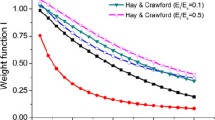Abstract
Conventional analysis of load displacement curves in nanoindentation experiments determine modulus by using the elastic portion of the unloading slope or power law fitting the unloading slope. For polymeric materials, however, this analysis is not adequate because they behave viscoelastically. In companion research, L. Cheng has developed analytical models for flat tip and spherical tip indentation using a three element Kelvin-Voigt model, with a spring in series with a parallel dashpot and a spring for compressible and incompressible materials.
Incompressible (v=0.5) polydimethylsiloxane coatings with thicknesses of 2 and 78 microns, a compressible (v=0.33) bulk polystyrene (PS) and a 16 Jim styrene-acrylate block copolymer coating (v=0.33) have been used to verify the models. The polymers were indented using flat tip and spherical tip indenters with a nanoindentation apparatus in creep (constant load) and relaxation modes (constant depth). The data was fit to the analytical models using a non-linear least squares fit algorithm varying three parameters. In general the fitted elastic and shear moduli compared favorably with conventional rheological and mechanical measurements on the same bulk polymers. However, it appears that the agreement for the thin film analysis can be improved by taking the hydrostatic pressure dependence of the modulus and substrate effects into consideration.
Similar content being viewed by others
References
M. F. Doerner, W. D. Nix, J. of Mat. Res., 1(4), 601–609 (1986)
W. C. Oliver, G. M. Pharr, J. of.Mater. Res., 7(6), 1564–1583 (1992)
T. W. Wu, J. Mater. Res., 6(2) 407–426(1991)
J. Mencik, M. V. Swain, Materials Forum, 18, 277–288(1994)
E. M. Arruda, M. C. Boyce, Int. J. of Plasticity, 9, pp. 697–720 (1993)
L. Cheng, L. E. Scriven, W. W. Gerberich, submitted to WCCM IV, Argentina, 1998
in house testing by Dow Coming
K. H. Hellwege, W. Knappe, F. Paul, V. Semjonow, Rheol. Acta., 6, 165 (1967)
M. S. Patterson, J. Appl. Phys., 35(1), 176–179 (1964)
R. W. Fillers, N. W. Tschoegl, Trans. Soc. Rheol., 21, 51(1977)
Author information
Authors and Affiliations
Rights and permissions
About this article
Cite this article
Stroiny, A., Gerberich, W.W. Experimental Analysis of Viscoelastic Behavior in Nanoindentation. MRS Online Proceedings Library 522, 159–164 (1998). https://doi.org/10.1557/PROC-522-159
Published:
Issue Date:
DOI: https://doi.org/10.1557/PROC-522-159




